
views
Handwriting Your Signature

Determine the content of your signature. If you were to look at the signatures of a thousand different people, you would probably notice that they not only vary significantly in their appearance, but also in the content of their signatures. Some people sign their entire name, some just their last, and some just their initials. Start by deciding exactly what you want to include in your signature. If you’re concerned about forgery, it may be a better option to make your signature a bit longer and legible by including your entire first and last name and writing clearly. It is so much easier to forge scribbled signatures than to copy the nuances of a legible one. Signatures that include just your initials (with or without the middle initial) are typically considered more formal and business-like than full-name signatures. Sometimes, people who don’t like their first name will leave it out entirely and sign with just their surname, or they may include just their first initial.

Print your signature. Before moving up into signing your name, start by printing it over and over. You may find that in the process of recreating your printed signature, you automatically begin to add flourishes and details in appropriate areas. Printing your signature will help you to analyze where you want to add or detract, and what should be embellished and what shouldn’t. Determine your favorite qualities of your printed signature. Do you like the slant, size, shapes of certain letters? Keep track of these so that you can recreate them when personalizing your signature. Pay attention to the size of your handwriting. Studies show that people with very small signatures tend to be overlooked, while people with very large signatures often are arrogant or grandiose. Try to keep your printed/signed name at an average size, similar to the size of your regular writing.

Determine how legible you want your signature to be. Before moving from printing to signing, you should aim for a certain level of legibility. Some people’s signatures are equally as legible as their print, while others look like scratches or scribbles on a page and are completely illegible. Although you want to make your signature difficult to replicate (which may come with illegibility), you want to stay true to your personality and avoid cluttering your signature. To make your signature more difficult to read, you can either push letters closer together, or flatten them and spread them further apart. If you don’t want to make your signature easy to read, avoid doing so by leaving out letters or using bad handwriting. These tactics are unprofessional and won’t make your signature look all that great.
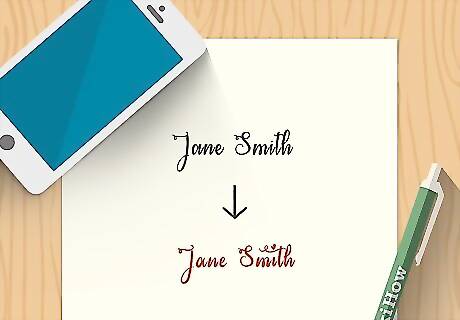
Begin making changes to your signature. On a piece of paper, practice signing your name in multiple different ways, trying out some of the changes you would like to make. Start small, and work your way up to bigger changes in the way you sign your name (rather than jumping into something totally new right away). Some options for changes may include: Greatly increasing the size of the capitalized letters in your name. Adding a flourish to the tail ends of letters (particularly ‘T,’ ‘Y,’ ‘E,’ and ‘G’). Changing the shape of round/elliptical letters (particularly ‘O,’ ‘U,’ ‘C,’ ‘R,’ ‘B,’ and ‘P’). Incorporating traditional cursive and calligraphy into your signature. Underlining parts of your name. Adding additional shapes and decorative elements.
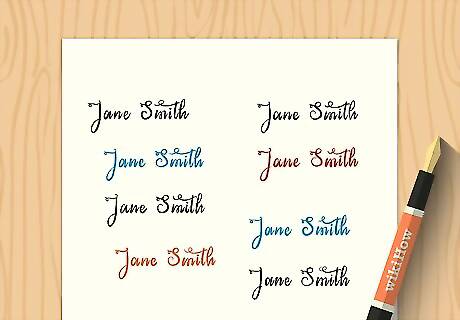
Perfect your signature. When you’ve chosen all that you want to add/detract from your current signature, start the work of incorporating in each aspect into your handwriting. Don’t make a huge change in your signature right away, as it will feel unnatural and you will likely forget some changes that you intended to make. Instead, slowly add and drop elements over the course of a few weeks until you have created a personalized signature. Practice writing your signature on a daily basis to help expedite this process. Consistency is a key element in changing your signature. If you can’t keep your signature relatively the same between each signing, then you should probably limit the number of changes you’re making. When in doubt, less is more. Although you may want to have a hugely elaborate signature, for the first few months that just might not happen. Keep it simple, and over time add more detail.
Creating an Email Signature

Consider the content of your signature. Unlike a handwritten or blog signature, an email signature is not meant to mimic the appearance of your actual handwritten signature, but rather add a bit of personal information at the bottom of every email you send. Typically this will include your full name, contact info, and mailing address. Avoid putting personal information, small catch phrases, or quotes in your email signature.
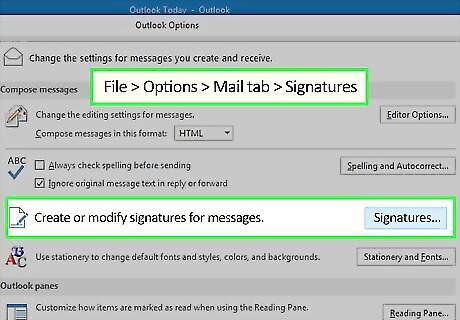
Create a signature in Outlook. If you have Microsoft Outlook, you can easily create an email signature. To create a signature in Outlook, open the program and take the following steps: Go to the ‘Tools’ menu, then select ‘Options,’ and then select ‘Mail Format’ Click the ‘Signatures’ button about halfway down the dialogue box Fill in your signature information. When you’re finished, click ‘Ok’, and then ‘Ok’ again in the earlier box.
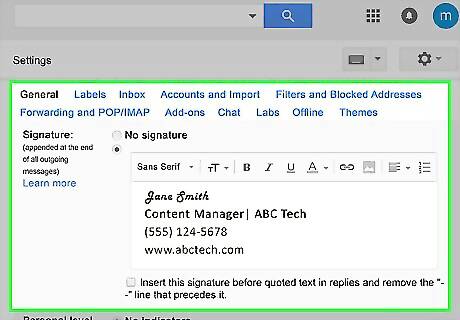
Create a signature in Gmail. To create a signature for your Gmail account, open your email and follow these directions: On the upper right corner of the screen, click the gear icon and then scroll and click ‘Settings; Find the ‘Signature’ section under settings, and select it Fill out your signature information, and click ‘Save Changes’ at the bottom in order to implement it.
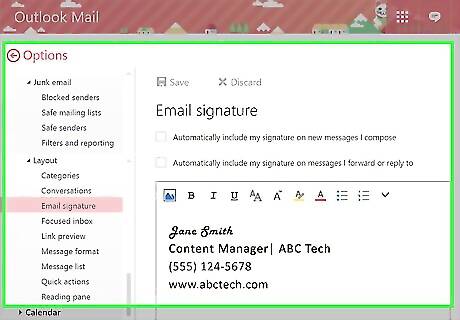
Create a signature in Hotmail. If you are interested in making a signature for your Hotmail email, open up your account and take the following steps: Click the gear icon on the top left corner, and scroll down to select the ‘More Mail Settings’ button. Locate the ‘Message Font and Signature’ button, and select it Enter in your signature as you would like it to appear in your emails, and hit ‘Save’
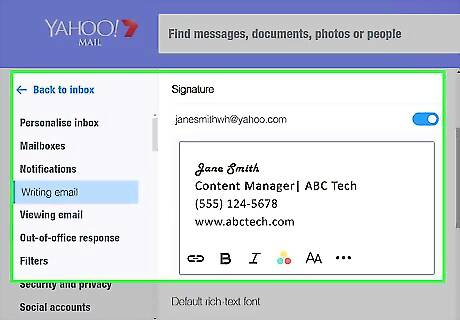
Create a signature in Yahoo Mail. Sign into your Yahoo mail account, and follow these directions in order to create a personalized signature: On the top right corner, select the ‘Options’ button and then locate the ‘Mail Options’ button and select it. Find the ‘Signature’ button on the left side of this page, and select it. Add in your signature as you would like it to appear, and select the ‘Show a signature on all outgoing mail’ button so that it sends automatically with your emails. Save your signature by selecting the ‘Ok’ button.
Creating a Blog Signature
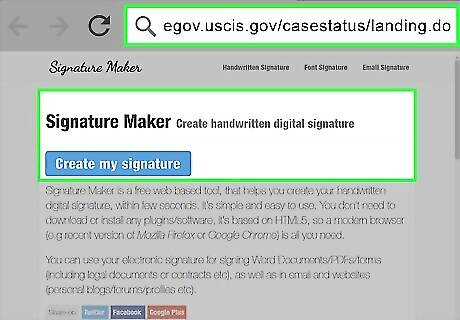
Use an online signature creation tool. With a recent boom in blogging has come a boom in blogging help - including creating a personalized blog signature. If you don’t want you actual signature online or lack graphic design skills, you can visit a website that will generate dozens of signature options for you. Simply visit a signature-creation site (such as Signature Maker or Sign Now), and follow the step-by-step directions to create your e-signature.
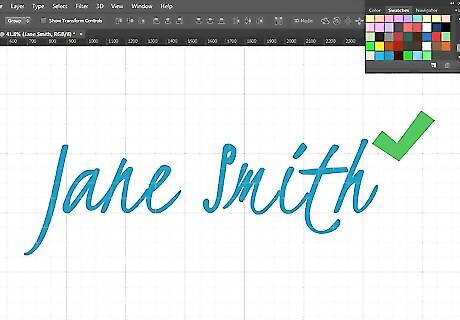
Create a signature as an image. If you’re big into graphic design, put your talents to use and create a personalized signature for your blog in your favorite photo-editing/graphic design program. Use the assortment of fonts that come with your program, or try your hand at drawing your signature electronically. This can then be saved as an image, and uploaded at the end of every blog post in a custom size.
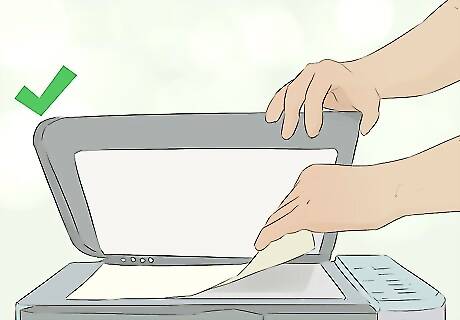
Scan a handwritten version of your signature. Although you may not want your real signature floating around the internet, you can draw an attractive version of your signature on paper and scan it onto your computer. This can then be downloaded onto a photo-editing software on your computer, edited to make more clear, and then uploaded as an image to your blog. Some phone’s offer apps that take scanner-like images for your blog or to save onto your computer.

Add your signature automatically to your blog posts. If you don’t want to have to deal with adding your signature manually to the end of each blog post, you can add a bit of code which will do all the work for you. Copy and paste: in the post template for your blog.


















Comments
0 comment